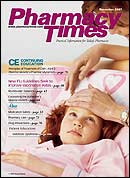Publication
Article
Pharmacy Times
HYPERTENSION WATCH
Home BP Monitoring Proves Successful
Blood pressure (BP) home monitoring as part of heart failuredisease management programs allows patients tocheck their BP regularly and encourages them to take stepstoward improved BP control, according to findings presentedrecently at the 22nd Annual Meeting of the AmericanSociety of Hypertension.
The study assessed the ability of home monitoring to promoteBP control for patients with heart failure (n = 625) andpatients with both heart failure and diabetes (n = 787). Theresearchers concluded that participation in BP home monitoringas part of heart failure disease management programsresulted in significantly improved BP control forpatients with heart failure and patients with heart failureplus diabetes. The findings demonstrated why patientsneed to be active participants in treating their condition bymonitoring their BP at home.
For more information on this presentation, visitwww.morningbp.com
Study Shows Genetic Link Between Body Clock and BP
A study reported in the Proceedingsof the National Academy of Sciences(September 4, 2007) found the geneBMAL1 to be a key component of thebody?s molecular clock. If the BMAL1 isinactivated, the body clock stops working,and blood pressure (BP) and bloodglucose levels are altered.
The Oxford researchers said thestudy provides direct evidence that agenetic change in BMAL1 is linked withhigh BP. The study also is the first evidencein humans of a direct causal linkbetween changes in the body clock anda greater risk of type 2 diabetes andhigh BP.
?The regulation of circadian rhythm iscentral to a wide range of biologicalprocesses, and this type of geneticstudy should be extended to other diseaseareas,? said study authorProfessor Dominique Gauguier, PhD.
The findings emphasized the needfor patients with high BP and chronicdiseases to monitor their BP at home.For information on this study, visitwww.morningbp.com
Are Patients Controlling Their BP?
A major problem for controlling high blood pressure (BP) isadherence to treatment, according to an editorial in the cardiologyspecial edition of The Lancet (August 18, 2007). Therationale for many patients with high BP is that it is a diseasethat can be cured, and they stop or reduce medication whenthe BP levels drop.
The editorial stated, ?Physicians need to convey the messagethat hypertension is the first, and easily measurable,irreversible sign that many organs in the body are underattack.? The editorial stressed that individuals with high BPneed to constantly monitor their BP to help them stay compliantwith their medication and have a complete picture oftheir BP on a daily basis. For more information on this editorial,visit www.morningbp.com
Morning Hypertension and Metabolic Syndrome Are Connected
A study of 181 patients with hypertension in an outpatientclinic examined the prevalence of morning hypertensionand metabolic syndrome. Using home-use sphygmomanometers,the researchers found that 43.6% of thepatients demonstrated morning hypertension.
The findings, reported in Hypertension Research, October29, 2006, indicated that only 48.1% of the patients had normalsystolic blood pressure (BP) both at the clinic and in themorning at home, whereas 72.9% of the patients demonstratednormal diastolic BP under the same conditions. After1 year, the researchers found that 43.6% of the patients stillshowed morning hypertension, and there was significantlyhigher prevalence of metabolic syndrome among patientswith morning hypertension. The researchers suggested theneed for more vigorous intervention in controlling BP. Forinformation on this study, visit www.morningbp.com
Morning BP Predicts EPO-induced Hypertension
A study of patients with mild-to-moderate renal impairmentwho had renal anemia requiring erythropoietin (EPO)treatment assessed whether morning home blood pressure(BP) could predict EPO-induced hypertension. BP control wasevaluated based on the relationship between office/clinic BPand home BP in the morning, according to findings reportedin Clinical Experimental Nephrology, March 2007.
The researchers found that, prior to EPO treatment, 38% ofthe patients had well-controlled BP, 30% had poorly controlledBP, 20% had masked hypertension, and 12% hadwhite-coat hypertension, indicating a predominance of morninghypertension. After EPO treatment, morning hypertensionin patients with masked hypertension and poorly controlledBP increased by 5%. There also was an 8% decline in the wellcontrolledcategory. For more information on this study, visitwww.morningbp.com
F A S T F A C T : High blood pressure precedes 74% of cases of heart failure in the United States.







